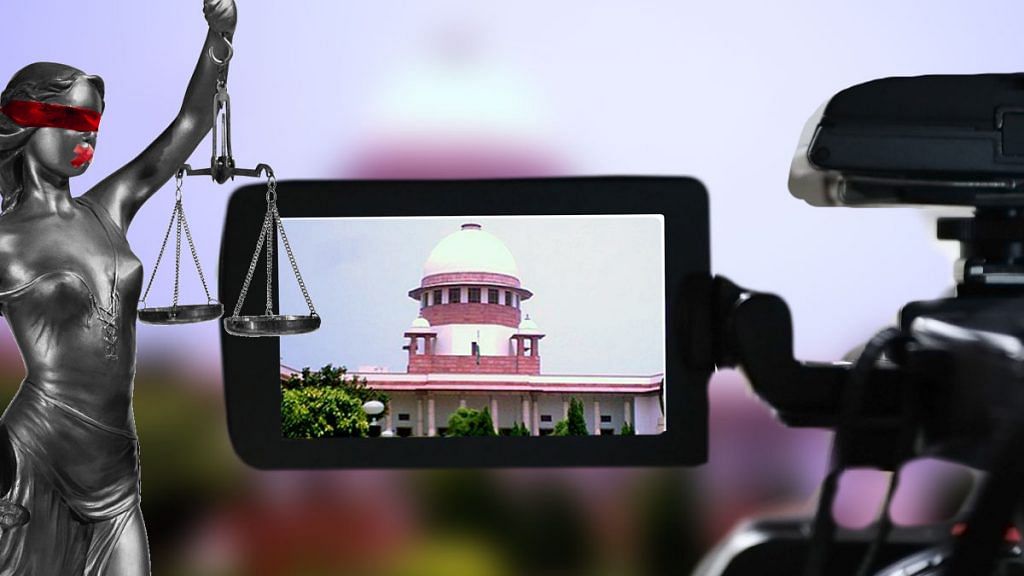Pressure on judiciary to be transparent has resulted in a travesty – a pilot project in two district courts where proceedings will be recorded without audio.
Why can’t Supreme Court proceedings be shown live, just like Parliament? The question has been asked for nearly two decades, but the judicial fraternity has managed to duck and dodge on some ground or the other.
The pressure on the judiciary to subscribe to what are now globally accepted transparency norms has, however, been relentless. And so, it turns out there’s been some sort of a rethink.
Sadly, what’s emerged from the churn is a travesty in the name of transparency – a pilot project in two district courts where proceedings will be recorded and that too without audio.
This was revealed by Law Minister Ravi Shankar Prasad in the Lok Sabha on the penultimate day of the winter session. He was responding to the debate on the judges’ salaries revision amendment bill, which proposes to raise their salaries as part of a periodic review.
Starting recording of proceedings with district courts, and that too without any audio, amounts to Parliament laying the condition that zila parishads and city council proceedings be first made live. By that yardstick, it would have taken ages for Parliament proceedings to be shown live.
No rationale
There’s no rationale as to why live telecast of proceedings can’t begin from the Supreme Court. Once the judiciary has accepted the principle behind live telecast, putting the onus of setting high standards on the lower courts is, to say the least, a mockery of the entire idea.
It’s quite possible that in some cases, proceedings cannot be shown live, for need of secrecy or privacy. Rules can be drawn up for exceptions, but to deal this way with a subject that is as old as the 1993 second judges case amounts to paying lip service.
One of the concerns often heard in legal circles is the question of providing infrastructure. Well, the law minister assured the Lok Sabha that the government will meet all demands of the Supreme Court to make live telecast happen.
“I would like to tell the house very clearly that the day the Supreme Court will tell us that they want to live telecast the proceedings of the Supreme Court, we will give everything that is required, as we have done in the case of e-courts or video-conferencing in many district courts,” Prasad assured the house.
The higher judiciary must realise that it’s important for the SC to be at par with Parliament on transparency standards. Not doing so widens an already worrying gulf with the legislature. This chasm was quite visible in this debate which, otherwise, went unnoticed in the noise over other contested political issues which dominated the session.
MPs united in criticising judiciary
The fact is this was just a judges’ salary revision amendment bill, which could be passed without much debate. In the case of civil servants, pay commission recommendations are implemented by way of an executive order, but for the judiciary, this has to happen through an act of Parliament.
As it turned out, the salaries bit was hardly debated, except for the aside that parliamentarians used the occasion to draw the attention of the Speaker to revise salaries of MPs.
But the telling part was how the house, transcending party lines, hit out against the judiciary on several counts. It’s rare to find the BJP, the Congress, the Trinamool Congress, and the Samajwadi Party, among others, on the same page in these days of bitterly contested electoral politics.
Prasad himself didn’t spare the judiciary when he questioned the logic of not letting the Prime Minister or his law minister have a say in judicial appointments. Yet, due respect was given in the end and everyone agreed to honour the autonomy of the judiciary.
Still, there was a sense of the house which the law minister said he would bear in mind, especially on the issue of creating an All India Judicial Service on the lines of the civil services. That again is a conversation, where the judiciary has asked the government to back off, saying this decision is the domain of the courts.
The bigger picture
While the judiciary can continue to fend off the legislature and executive, it must step back and absorb the bigger picture. The judiciary is coming under the scanner not because of its actions but the lack thereof.
The inefficiencies are so serious that it’s no longer a problem of the judiciary alone. Why would anyone not question appointments when 5,984 positions are vacant across courts? Or for that matter, as TMC MP Kalyan Banerjee recounted, how it took over 15 years for him to settle a case for a client.
Yet, the SC continues to defend its appointment process even though half a dozen high courts are being run by acting chief justices.
If these are knotty, complex problems to resolve, then starting live telecast of SC proceedings is surely less complicated, particularly when the headache of setting up the infrastructure is that of the government.
The time for this reform has come. In fact, it’s overdue. The SC must embrace it and set an example for lower courts, not the other way round. But first, it must recognise that it can no longer duck and hope for the issue to blow over – like any timely idea, it will keep returning with stronger force, even if it means ruining an innocuous pay hike discussion.
